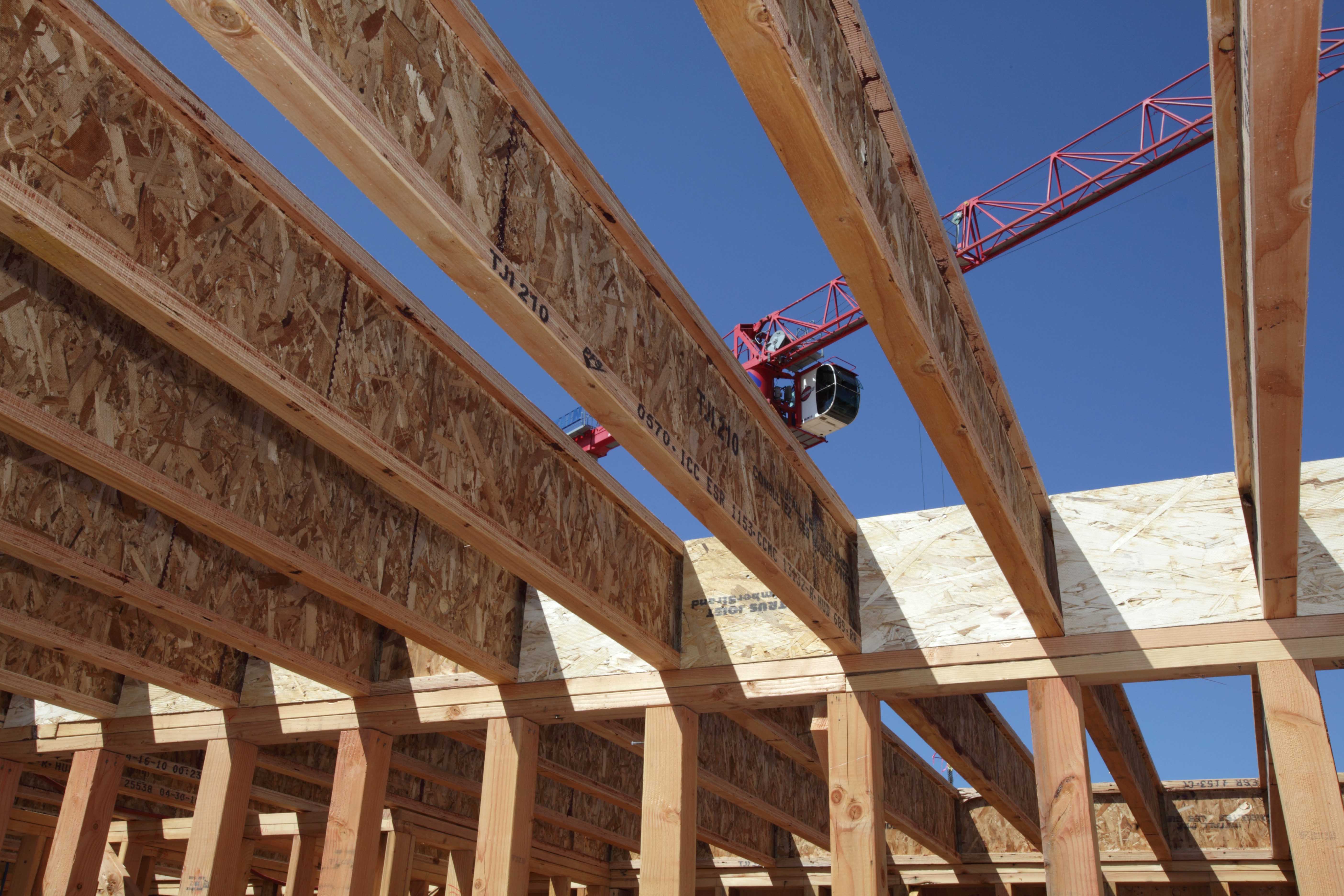When designing a wood-framed floor system for residential projects, building to meet the applicable codes is only one step in the design process. Having met code requirements, there is an array of choices a designer must consider that impact the day-to-day use of the floor.
The size and depth of Trus Joist® TJI® joists and related framing members, and their on-center spacing, as well as the thickness of the subfloor and the manner in which they are installed, directly influence how the floor will feel and perform over time. Taking the time to consider the floor as a system solution as a part of the project design, beyond simply complying with code requirements, can contribute directly to occupant satisfaction and their perceptions of overall quality.
Assessing the Challenges
Various floor assembly components will affect a floor’s performance.
Basic stiffness
This is a combination of joist depth and span. Greater basic stiffness increases frequency and assembly stiffness. For a given span, increasing the joist depth results in the greatest increase in basic stiffness.
Joist spacing and deck stiffness
Reduced joist spacing or increased deck thickness generally improves floor performance by increasing assembly stiffness.
Composite action
‘Composite action’ is a measure of how the assembly’s deck component interacts with the joist to effectively increase basic stiffness. Increasing stiffness (i.e., thicker deck) and/or use of construction adhesives increases composite action.
Continuity
Joists that are continuous over several supports generally enhance floor performance because a joist in a continuous span would deflect less than the same joist in a simple span application. Care must be taken if such joists continue into an adjoining occupancy as these members can transmit vibration and sound through the floor assembly.
Ceilings
A directly applied (not suspended) gypsum ceiling or strapping—minimum 1x4 applied flat to the joist at 1.5 m (5 ft) on-centre (o.c.) or less—improves floor performance. Assembly stiffness and damping are slightly increased.
Bridging/blocking
Bridging/blocking and strapping properly installed at 2.4 m (8 ft) o.c. or less enhance floor performance. Bridging/blocking and strapping should be continuous from wall to wall (or support beam) and evenly spaced along the floor span. When there are interruptions from HVAC equipment—such as a duct running parallel to the joists in the floor cavity—or changes in joist depth, there must be proper consideration for detailing.
Beams
When joists are supported on beams, there is a small increase in deflection under normal working loads, which slightly reduces floor performance. Beams designed for relatively large tributary floor areas have less effect.
Additional contributing factors
Full-height framed partitions that are transverse to the joist and away from supports have the effect of damping vibrations, which improves floor performance. However, such partitions must be solidly connected to the floor assembly.
It is important to remember a floor assembly deflects even under light working loads. Bridging that splits during installation and ductwork that rubs against joists, can produce noise that may reduce the floor’s perceived quality.
The most effective and economical technique for ensuring good floor performance is the identification of the proper depth, series and spacing for the joist during the design phase. A deeper, stiffer joist is typically the most economical solution for increasing floor performance for a given span.
Problem Areas
Although it is important to ensure all of the structure meets strength and service requirements, there are a few areas of a floor more likely to attract attention from occupants.
Long spans next to short spans
In a room in which an area of long span joists occur next to short span joists, the occupant may perceive the floor to be more solid in the areas with the short spans. To accommodate these differences in floor performance, designers can tighten the spacing of the joists or specify stiffer joists.
Long spans combined with higher dead loads
In multi-family projects, open floor plans, combined with heavy kitchen islands or concrete toppings, can be another trouble spot. To reduce the possibility of unacceptable vibration, the size of members under the dead load can be increased, or spacing tightened up, even when the code allows for wider spacing.
Joists used to their maximum spans
When reaching the maximum strength or deflection limit for a certain joist, the floor system may be economical and strong enough, but it also may undergo more deflection or bounce than expected. Depending on the client’s expectations, it may be better to consider an alternative, stiffer floor assembly, and evaluate the effect on performance to make the best system choice.
Performance Versus Cost
While it is desirable to specify a very stiff floor with minimal deflection, there are always economic considerations that may not make this approach reasonable.
Weyerhaeuser has developed a proprietary system called TJ-ProTM Ratings that predicts floor performance based on assembly inputs and assigns a rating value. The TJ-Pro Ratings helps specifiers determine a floor system design that offers a balance between desired performance and cost. Builders can dial in floor feel by evaluating the combined effects of TJI joist series, depth, spacing and other system parameters, such a deck thickness, leading to a floor that meets the performance expectations of each homeowner.
The rating system can be targeted to different client preferences or even to individual areas of the floor, taking into consideration how different rooms will be used and occupied. For example, a condo’s rec room designed for entertaining might target a different rating than the dining area or kitchen.
For more information on the TJ-Pro Ratings, click here.
Up-Front Decisions
Even when built to code, many engineered wood floor systems still have room for performance improvements that can reduce the likelihood of vibration and subsequent occupant discomfort. Design choices upfront—such as joist spacing, stiffness or span continuity—can significantly affect the floor system performance. “Performance-focused” design utilizing software and balancing economic factors, combined with reasonable care during installation, can help avoid potential occupant dissatisfaction down the road.





